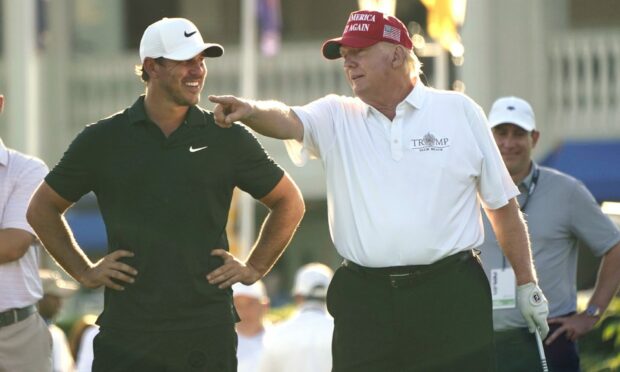Golf’s great and treasured lexicon has been taking a hammering in recent times.
We at T2G are still at the barricades with other, right-thinking souls as we fight the battle to retain our great and historic golfing terms.
They can’t control what we say
Terms used in golf many of which are now sadly defunct . pic.twitter.com/JSt1HTQ0D5
— James Woods (@Stymied69R) October 19, 2022
We utterly refuse to accept the frankly fascistic attempt of the ruling bodies (I’d like to think this was a mostly USGA thing rather than R&A) to control the very words we say.
For us, it’s still half, halved and all square. They’re still hazards. It’s still dormie (or dormy: remaining consistent, you can spell it however you like).
We still love stymie even though in golf, it’s obsolete from previous rule changes.
We even have ‘bisque’, which I wasn’t aware of until very recently. It does not involve be-souped crustaceans, but a method of use of the handicap strokes you are allotted in a game.
I know that one due to a helpful recent tweet by the golf history enthusiast James Woods (not the loony actor). This also threw up ‘foozle’, which is a term for “any really bad stroke”.
To be honest, I don’t see myself using that one much. I have my own words, dating from Anglo-Saxon traditions, for those.
Anyway, our position on the barricade is that we utterly deplore the thinking behind removing these treasured terms. Seriously, as if ‘tied’ is in any way simpler than saying “all-square”.
And we’ll simply carry on using the old terms regardless. Excommunicate us if you will.
This year’s new terms
R&A says their position on Turnberry as Open venue has not changed since their statement of Jan 11, 2021 – which basically said no chance the foreseeable future. https://t.co/2aMZE24UMq
— Bob Harig (@BobHarig) October 28, 2022
But sadly, golf’s lexicon this year has also getting a number of new and dispiriting terms quite apart from those insisted on by the ruling bodies.
You know, like ‘sportswashing’. Or (ugh) ‘ecosystem’. ‘Plaintiff’, ‘appellant’ and most recently ‘disclosure’.
And finally, ‘gaslighting’.
This is defined by “manipulating another person into doubting their own perceptions, experiences or understanding of events”. Basically, in our world, it’s telling untruths until such time that people basically give up on the truth.
This is how we should generally judge Donald Trump’s assertion last week when he was hosting the LIV Golf season finale that the R&A wanted The Open to return to Turnberry.
“They want to, I can tell you they want to come back,” he told reporters. “The Open wants to come back.
“It is rated the No 1 course in Europe now. We did a big surgery and it has gotten great reviews, even from people who hate me. They want the Open to go back.”
This was faithfully reported by the good journalists present. But nevertheless, it was simply not true.
Martin Slumbers, chief executive of the R&A, reiterated – with some frustration – that their policy had not changed. It is, if you translate R&A diplomat-speak, we’re not going anywhere near that place until that man’s name is off it.
Although official stated policy for just two years, it’s actually been unofficial policy since 2015. Then the R&A were chastened by Trump’s attention-seeking antics during the Women’s Open at Turnberry.
“Everyone wants to go to Turnberry,” added Trump last week. That’ll be why it lost £2.3 million last year, no doubt, the sixth successive year it lost money.
A great course, but…
R&A chief Martin Slumbers says decision on LIV golfers in Open will come early in 2023, frustrated by Trump’s Turnberry comments https://t.co/R8968qFnH0
— John Huggan (@johnhuggan) October 29, 2022
To be fair to Trump, he is right that even people who hate him think the Ailsa Course, remodelled by Martin Ebert, is one of the best in Europe, if not outright the No 1.
And to also be fair, no owner – the Dubai-funded Leisurecorps before Trump, all the way back to British Transport Hotels – has made a profit out of Turnberry.
It is beautiful. The course was magnificent even before Ebert improved it. The situation is stunning. The hotel was sumptuous even when I last stayed in it about 15 years ago, when it was definitely fraying a little around the edges.
But the place has always been a money pit. And it’s comfortably the worst venue in the pool of courses for the modern Open.
We can talk all we like about the course deserving the championship. If that was the only requirement it would be there already. 1977 and 2009 were two of the greatest Opens ever.
But of course, it isn’t. Turnberry has no hope of ever getting the 200,000 spectators for the week that is the championship’s benchmark. They struggled to clear 120,000 last time.
It’s a tackle to get to, with one real road in and out, already crowded with lorries headed for the ferries at Stranraer.
There’s not nearly enough accommodation nearby. And although the R&A would never admit to this publicly, infrastructure costs and reduced attendance means they would lose money on the championship if they went there.
The money does matter here
The Open is the financial driver for all their treasured good works in golf across the globe. They’re not in the business of having that marginalised for a few nice views of Ailsa Craig.
In these respects, it doesn’t really matter that Trump is the owner. Although I suppose the R&A might just be convinced to take a one-time hit on going there if his name wasn’t plastered all over it.
But The Open’s not going to Turnberry. No matter how often Trump says otherwise, he can’t gaslight us on this.
